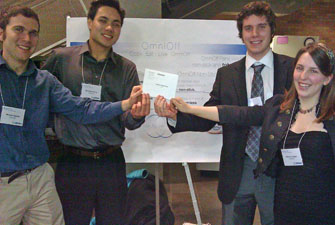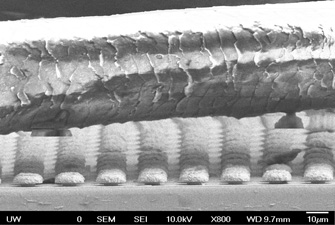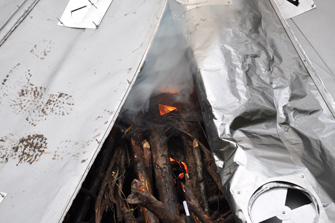
OmniOff's Mike Siedlik, Nick Wang, Grant Williamson, and Kathryn Cogert winning first place at the UW Business's Science and Technology Showcase.
One bright September morning in Benson Hall, a meeting was held to discuss the state of ChemE today, and how to better prepare students for tomorrow. At the annual Advisory Board meeting, members sat down with alums, investors, and campus experts, to consider a growing employment option for chemical engineers. As entrepreneurs and start-up founders, ChemE students, faculty, and graduates are using their knowledge and lab work to create innovative solutions and products.
One group of ChemE student entrepreneurs is working to make cooking healthier. To reduce the Perfluorocompound emissions from traditional non-stick cookware, student group OmniOff is developing a new class of non-stick surfaces. “We utilize material science innovations to create non-toxic, non-stick cookware that is 100% stainless steel with no coatings, making it 100% compatible with the health-conscious cookware market,” said Kathryn Cogert, team CEO.
The student venture started in the fall of 2011, when undergraduates Mike Siedlik, Nick Wang, Grant Williamson, and Cogart enrolled in a Special Projects in Chemical Engineering Design course. “Instead of the traditional process design, the undergraduate members of OmniOff are learning how to do product design, a skill that is in increasing demand,” Cogert said.

These metallic toadstool structures make the OmniOff surface non-stick. Each toadstool is about 1/10 the size of a human hair.
Cogert has picked up several skills having gone through the process of designing and pitching a prototype. “The class has taught me how one can successfully create one’s own job, a skill that is very worthwhile in today’s uncertain times.”
OmniOff has had help outside the classroom. Keeler Investments Group, LLC, a family-funded and managed investment group, guides fledgling innovators. Keeler Partner Shelley Whelan works with early-stage investments, and helped OmniOff as they prepared for business competitions.
Keeler has also worked with the ChemE alum company Modumetal. “Our investment in Modumetal introduced us to the exciting things coming out of Dr. Schwartz’s lab and we fostered a closer relationship with his department,” Whelan said.
Co-founded by John Whitaker (PhD ’03) in 2007, Modumetal produces a nanolaminated alloy stronger and lighter than steel. “Modumetal’s structure gives it unique performance advantages in both strength and corrosion resistance,” said Whitaker. The sustainable manufacturing process uses electricity as the direct input form of energy, which Whitaker sees a major shift in how metals are manufactured. “It affords inherent efficiencies and reduces demand for metal raw materials.”
“When I was first exposed to nanolaminated materials at the UW, I never imagined where it would take me,” he said. “I believe well-trained chemical engineers have a mindset that is uniquely suited to commercializing molecular-scale innovations.” The company has foundational patients, customers from Fortune-500 companies, and is working to scale up production. “Modumetal’s vision is a big one: to revolutionize manufacturing. To change and improved the way things are made,” he said.

MicraMetal's direct writing plating prints on a specified area, instead of the entire metal plate. The plated metals above are measured in micrometers.
Nelson’s graduate work helped prepare him to start MicraMetal. “The experience of writing papers, preparing presentations, posters, and giving talks, failed experiments, unexpected results, and going through longer periods of time working on specific problems—all of these experiences can help the technology entrepreneur.” MicraMetal is currently looking for funding to help advance the technology, expand to new markets and sell the DWP machine tools.
Karl Schmidt (BS ’96), CEO of Mirador Biomedical, created a company from the ashes of former failed startup. Economic downturn and clinical trial complications ended a neuromodulation company, but started a biomedical one.
Founded in 2009, Mirador makes pressure measuring biomedical devices, saving time, money, and lives by giving fast pressure readings. “Our devices provide definitive, quick information,” said Schmidt. “Once the needle is in place, the physician gets the pressure immediately.”
The devices are used in several medical procedures like catheter insertion, preventing strokes by indicating when an artery is punctured, and in juvenile spinal taps. The device shortens the time a baby or child undergoes a spinal tap by giving instant pressure readings instead of the physician waiting for the fluid level to creep up.
“We incorporate technology into devices that are kinda dumb. Making them smarter, by providing information that you wouldn’t normally get,” Schmidt said. Mirador’s devices are used locally at UW Medicine, Seattle Children’s Hospital, and Harborview Medical Center.
Schmidt found his ChemE degree a useful tool in product innovation. “A ChemE degree gives you a solid background in problem solving skills. It helps you identify problems and solutions without a road map.”

Carbon Cultures' prototype blanket efficiently burns forest refuse into biochar, a useful agricultural product.
In 2011, the group received funding through Prof. Schwartz’s NSF Innovation Corps (I-Corps) grant, one of 21 groups to be awarded in the program’s inaugural year. With the small-scale prototype working, the group is conducting field tests to improve it for large-scale use. They hope to be in full-scale operations in the next year, after finding capital for full-scale operations and product delivery.
“The commercialization of this technology will go a long way to solve many issues that face landowners — forest lands as well as agricultural lands,” said Knoth. “By taking our technology out of the lab and working to build the commercial application for it, and our products will be useful tools for others.”
Research developed in the lab launched Boeing-Roundhill Professor Shaoyi Jiang’s, Zwitter Technology, LLC. Founded by Boeing-Hill Professor Shaoyi Jiang in 2009, the company makes zwitterionic polymers. These polymers, created in Jiang’s lab, prevent biofouling, the unwanted biomolecular absorption and microorganism attachment to surfaces like sea vessels and medical devices. Zwitterionic polymers creating molecular coatings that interfere with protein binding making it impossible for proteins to bind to the surface.
The company, currently funded by Small Business Innovation Research (SBIR) grant, is located on commercialization space on the UW campus.